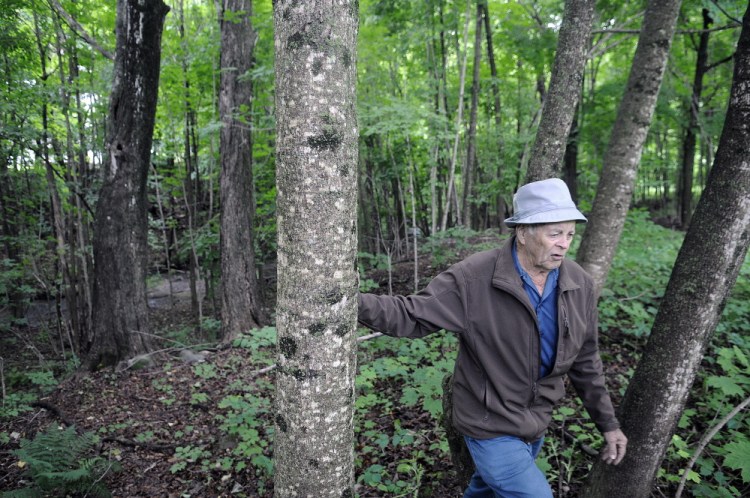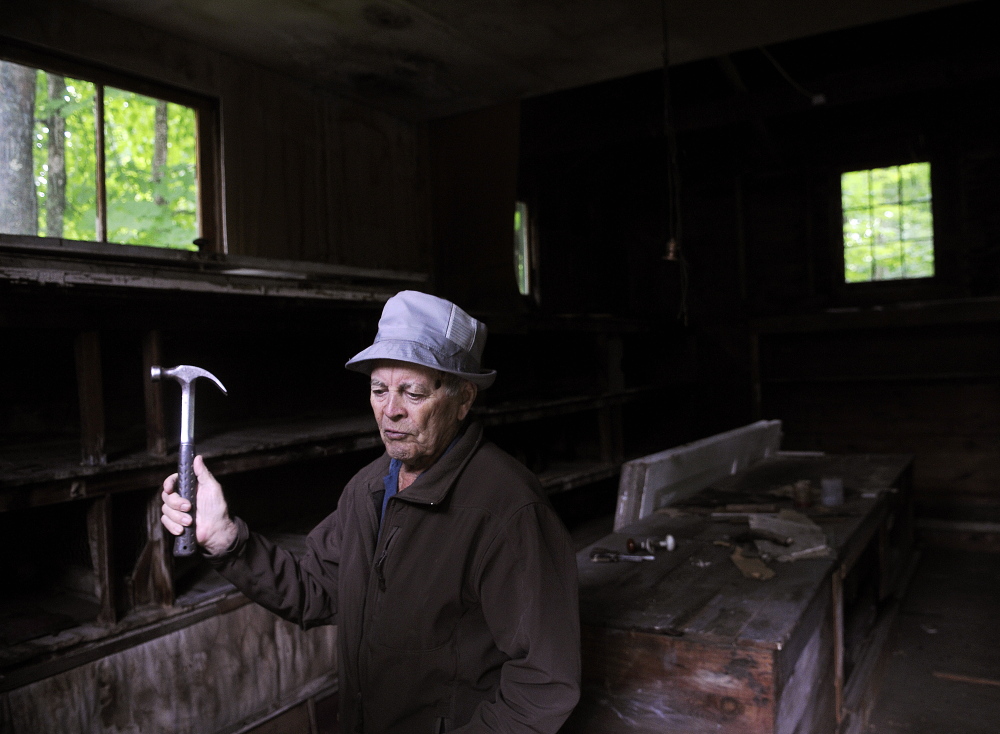MONMOUTH — Lloyd McCabe can dish on the town’s history with the vibrance of a poet and the memory of a computer, but now McCabe is staking a claim to become part of that history.
McCabe, 90, recently purchased land bordering Mud Stream off Maple Street that he hopes will become the Lloyd and Vera Beth McCabe memorial park. McCabe has already designed the plaque. Now all he needs is for voters to approve the donation.
“It’s a tremendous gesture,” said Public Works Director Herb Whittier, who also serves on the town’s Conservation Commission. “It’s a small lot, but it’s a nice lot.”
The half-acre parcel about three-tenths of a mile east of Maine Street is marked only by an old shed that once was used to raise rabbits and the crumbling remains of a coal shed foundation that is hidden by thick underbrush. The plot, which McCabe paid $5,000 to buy from the Monmouth Museum earlier this year, cannot be used as a house lot. The thin, long lot is bordered on the front by Maple Street and on the back by Mud Creek, which runs from nearby Cochnewagon Lake and eventually spills into Annabessacook Lake. The quiet spot is covered with lush plants and is dotted with large trees.
“Look at that maple,” McCabe said. “You could get enough sap to make it all worthwhile.”
McCabe’s tale of coming to own the lot, like many of his stories, delves deeply into town history. The building near the road is called the rabbit hutch, because the former station master for Maine Central Railroad used to raise the furry creatures in the 1930s.
Earl Flanders, who eventually donated the land and buildings that now comprise the Monmouth Museum, later purchased the rabbit hutch and moved it to the Maple Street location for storage. The property was part of Flanders’ donation to the museum.
McCabe said the property was originally known as the coal shed property because coal arriving in town on trains would be stored in a large building in the northwest corner near the road.
“My father helped deliver some of that coal in the 1930s,” McCabe said. One of those deliveries went to accomplished artist and Cumston Hall designer Harry Cochrane, who by that time had fostered an interest in photography. McCabe said Cochrane took time to show McCabe’s father his film developing room.
The turning point in McCabe’s tale came about 20 years ago when the coal shed collapsed.
“The museum made the mistake of not rebuilding it within a year,” McCabe said. “They lost the ability to sell this as a house lot.”
McCabe said that by the time the coal shed collapsed, town and federal rules made the property a nonconforming lot, which means the museum had one year to rebuild the shed to maintain the grandfathered approval. McCabe originally hoped to build a house on the property, but after meeting the town’s road setback and the Environmental Protection Agency’s stream setback, his house would be three-feet wide. McCabe, who calls himself an “honorary member” of the museum, is disappointed building rights expired.
“The museum could have gotten more money if they’d had a $30,000 house lot,” McCabe said.
McCabe decided to purchase the land anyway and donate it to the town for a park named in honor of his wife, Vera Beth, who died in 2012, and himself. The only strings McCabe has tied to the donation is that it remain a park and that the town erect a sign memorializing the couple. The prototype reads, “Town of Monmouth Nature Park. In memory of Lloyd and Vera Beth McCabe.”
The couple married in 1983 when Lloyd was 59 and Vera was 62. The marriage was a first for Lloyd.
“I helped my parents on the farm,” he said. “There wasn’t money enough coming in to support another family. It was after my mother died I started thinking I should look for a wife.”
Now the town and the museum could benefit from his effort to honor their nearly 30 years of marriage. Sheila Sanford, president of the board for the Monmouth Museum, said the $5,000 raised by the property sale will be combined with money from the Tax Increment Financing district the town created to improve the downtown.
“It’s significant to us because we had a property we couldn’t really use,” Sanford said. “Mr. McCabe thought it would be a good idea to buy it and donate it for a park.”
All of the museum’s buildings are at least 100 years old. The bulk of the improvements will be limited to new paint, but there are plans for more substantial projects, such as a new porch on the carriage house.
“When it’s all repaired, it will look better and be much nicer for people to use,” Sanford said. “Each one of those things we do enhances the appearance of the community.”
The museum property includes Quinlivan Park near the blacksmith shop on Main Street. There has been discussion about connecting that park to the McCabe park by a foot trail along the stream, but the idea presents challenges because of ordinances designed to protect the stream. It remains to be seen if those obstacles could be overcome.
Any effort to develop plans for the property are on hold until voters decide whether or not to accept McCabe’s donation. Town Manager Curtis Lunt said the decision will likely go to voters at a special town meeting that would likely include other ballot questions as well. Lunt said it will be at least six weeks before that meeting takes place.
“We’re grateful for the donation, but it’s up to the town’s people to accept real estate,” Lunt said.
Should voters give their approval, Whittier says there is plenty of potential for the lot, including seating and picnic tables.
“There are possibilities there,” Whittier said. “I think you could do some things with it without spending a lot of money.”
Craig Crosby — 621-5642
Twitter: @CraigCrosby4
Send questions/comments to the editors.




Success. Please wait for the page to reload. If the page does not reload within 5 seconds, please refresh the page.
Enter your email and password to access comments.
Hi, to comment on stories you must . This profile is in addition to your subscription and website login.
Already have a commenting profile? .
Invalid username/password.
Please check your email to confirm and complete your registration.
Only subscribers are eligible to post comments. Please subscribe or login first for digital access. Here’s why.
Use the form below to reset your password. When you've submitted your account email, we will send an email with a reset code.